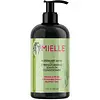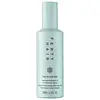What's inside
What's inside
 Key Ingredients
Key Ingredients

No key ingredients
 Benefits
Benefits

 Concerns
Concerns

 Ingredients Side-by-side
Ingredients Side-by-side

Water
Skin ConditioningGlycerin
HumectantBehentrimonium Methosulfate
Cetearyl Alcohol
EmollientStearyl Alcohol
EmollientPrunus Amygdalus Dulcis Oil
Skin ConditioningCetyl Alcohol
EmollientTriethyl Citrate
MaskingOlea Europaea Fruit Oil
MaskingParfum
MaskingBiotin
AntiseborrhoeicPersea Gratissima Oil
Skin ConditioningSesamum Indicum Seed Oil
EmollientCeteareth-20
CleansingRosmarinus Officinalis Leaf Oil
MaskingZingiber Officinale Root Oil
MaskingMentha Piperita Oil
MaskingPropylene Glycol
HumectantChamomilla Recutita Flower Extract
MaskingVaccinium Myrtillus Fruit/Leaf Extract
AstringentSaccharum Officinarum Extract
MoisturisingCitrus Aurantium Dulcis Fruit Extract
MaskingCitrus Limon Fruit Extract
MaskingAcer Saccharum Extract
Skin ConditioningPhenoxyethanol
PreservativeCaprylyl Glycol
EmollientPolysorbate 20
EmulsifyingWater, Glycerin, Behentrimonium Methosulfate, Cetearyl Alcohol, Stearyl Alcohol, Prunus Amygdalus Dulcis Oil, Cetyl Alcohol, Triethyl Citrate, Olea Europaea Fruit Oil, Parfum, Biotin, Persea Gratissima Oil, Sesamum Indicum Seed Oil, Ceteareth-20, Rosmarinus Officinalis Leaf Oil, Zingiber Officinale Root Oil, Mentha Piperita Oil, Propylene Glycol, Chamomilla Recutita Flower Extract, Vaccinium Myrtillus Fruit/Leaf Extract, Saccharum Officinarum Extract, Citrus Aurantium Dulcis Fruit Extract, Citrus Limon Fruit Extract, Acer Saccharum Extract, Phenoxyethanol, Caprylyl Glycol, Polysorbate 20
Water
Skin ConditioningCetearyl Alcohol
EmollientSaccharomyces Cerevisiae Extract
Skin ConditioningGlycerin
HumectantHydrolyzed Vegetable Protein
Skin ConditioningPereskia Aculeata Callus Extract
Panthenol
Skin ConditioningCamellia Sinensis Leaf Extract
AntimicrobialArginine
MaskingAlanine
MaskingAspartic Acid
MaskingGlycine
BufferingHistidine
HumectantIsoleucine
Skin ConditioningPCA
HumectantPhenylalanine
MaskingProline
Skin ConditioningSerine
MaskingTartaric Acid
BufferingThreonine
Valine
MaskingSodium PCA
HumectantMomordica Cochinchinensis Seed Extract
Skin ConditioningSalvia Hispanica Seed Extract
EmollientTrehalose
HumectantHelianthus Annuus Seed Extract
Skin ConditioningVaccinium Myrtillus Seed Oil
Skin ConditioningRicinus Communis Seed Oil
MaskingCocos Nucifera Oil
MaskingHydrolyzed Hyaluronic Acid
HumectantSodium Hyaluronate
HumectantGalactoarabinan
Brassica Campestris/Aleurites Fordi Oil Copolymer
Skin ConditioningArachidyl Alcohol
EmollientBehenyl Alcohol
EmollientLactobacillus Ferment
Skin ConditioningArachidyl Glucoside
EmulsifyingGlyceryl Ricinoleate
EmollientGlycolic Acid
BufferingHydroxypropylammonium Gluconate
HumectantHydroxypropylgluconamide
HumectantLactic Acid
BufferingLeuconostoc/Radish Root Ferment Filtrate
AntimicrobialPolyquaternium-59
UV AbsorberSodium Lactate
BufferingSorbic Acid
PreservativeTocopherol
AntioxidantXylitol
HumectantCitric Acid
BufferingPropanediol
SolventButylene Glycol
HumectantSodium Hydroxide
BufferingSodium Phosphate
BufferingParfum
MaskingCaprylyl Glycol
EmollientPotassium Sorbate
PreservativeSodium Benzoate
MaskingEthylhexylglycerin
Skin ConditioningBenzyl Alcohol
PerfumingCetrimonium Chloride
AntimicrobialPhenoxyethanol
PreservativeBehentrimonium Chloride
PreservativeAlpha-Isomethyl Ionone
PerfumingBenzyl Salicylate
PerfumingHexyl Cinnamal
PerfumingLimonene
PerfumingLinalool
PerfumingWater, Cetearyl Alcohol, Saccharomyces Cerevisiae Extract, Glycerin, Hydrolyzed Vegetable Protein, Pereskia Aculeata Callus Extract, Panthenol, Camellia Sinensis Leaf Extract, Arginine, Alanine, Aspartic Acid, Glycine, Histidine, Isoleucine, PCA, Phenylalanine, Proline, Serine, Tartaric Acid, Threonine, Valine, Sodium PCA, Momordica Cochinchinensis Seed Extract, Salvia Hispanica Seed Extract, Trehalose, Helianthus Annuus Seed Extract, Vaccinium Myrtillus Seed Oil, Ricinus Communis Seed Oil, Cocos Nucifera Oil, Hydrolyzed Hyaluronic Acid, Sodium Hyaluronate, Galactoarabinan, Brassica Campestris/Aleurites Fordi Oil Copolymer, Arachidyl Alcohol, Behenyl Alcohol, Lactobacillus Ferment, Arachidyl Glucoside, Glyceryl Ricinoleate, Glycolic Acid, Hydroxypropylammonium Gluconate, Hydroxypropylgluconamide, Lactic Acid, Leuconostoc/Radish Root Ferment Filtrate, Polyquaternium-59, Sodium Lactate, Sorbic Acid, Tocopherol, Xylitol, Citric Acid, Propanediol, Butylene Glycol, Sodium Hydroxide, Sodium Phosphate, Parfum, Caprylyl Glycol, Potassium Sorbate, Sodium Benzoate, Ethylhexylglycerin, Benzyl Alcohol, Cetrimonium Chloride, Phenoxyethanol, Behentrimonium Chloride, Alpha-Isomethyl Ionone, Benzyl Salicylate, Hexyl Cinnamal, Limonene, Linalool
Ingredients Explained
These ingredients are found in both products.
Ingredients higher up in an ingredient list are typically present in a larger amount.
Caprylyl Glycol is a humectant and emollient, meaning it attracts and preserves moisture.
It is a common ingredient in many products, especially those designed to hydrate skin. The primary benefits are retaining moisture, skin softening, and promoting a healthy skin barrier.
Though Caprylyl Glycol is an alcohol derived from fatty acids, it is not the kind that can dry out skin.
This ingredient is also used as a preservative to extend the life of products. It has slight antimicrobial properties.
Learn more about Caprylyl GlycolCetearyl alcohol is a mixture of two fatty alcohols: cetyl alcohol and stearyl alcohol. It is mainly used as an emulsifier. Emulsifiers help prevent the separation of oils and products. Due to its composition, it can also be used to thicken a product or help create foam.
Cetearyl alcohol is an emollient. Emollients help soothe and hydrate the skin by trapping moisture.
Studies show Cetearyl alcohol is non-toxic and non-irritating. The FDA allows products labeled "alcohol-free" to have fatty alcohols.
This ingredient is usually derived from plant oils such as palm, vegetable, or coconut oils. There is debate on whether this ingredient will cause acne.
Due to the fatty acid base, this ingredient may not be Malassezia folliculitis safe.
Learn more about Cetearyl AlcoholGlycerin is already naturally found in your skin. It helps moisturize and protect your skin.
A study from 2016 found glycerin to be more effective as a humectant than AHAs and hyaluronic acid.
As a humectant, it helps the skin stay hydrated by pulling moisture to your skin. The low molecular weight of glycerin allows it to pull moisture into the deeper layers of your skin.
Hydrated skin improves your skin barrier; Your skin barrier helps protect against irritants and bacteria.
Glycerin has also been found to have antimicrobial and antiviral properties. Due to these properties, glycerin is often used in wound and burn treatments.
In cosmetics, glycerin is usually derived from plants such as soybean or palm. However, it can also be sourced from animals, such as tallow or animal fat.
This ingredient is organic, colorless, odorless, and non-toxic.
Glycerin is the name for this ingredient in American English. British English uses Glycerol/Glycerine.
Learn more about GlycerinParfum is a catch-all term for an ingredient or more that is used to give a scent to products.
Also called "fragrance", this ingredient can be a blend of hundreds of chemicals or plant oils. This means every product with "fragrance" or "parfum" in the ingredients list is a different mixture.
For instance, Habanolide is a proprietary trade name for a specific aroma chemical. When used as a fragrance ingredient in cosmetics, most aroma chemicals fall under the broad labeling category of “FRAGRANCE” or “PARFUM” according to EU and US regulations.
The term 'parfum' or 'fragrance' is not regulated in many countries. In many cases, it is up to the brand to define this term.
For instance, many brands choose to label themselves as "fragrance-free" because they are not using synthetic fragrances. However, their products may still contain ingredients such as essential oils that are considered a fragrance by INCI standards.
One example is Calendula flower extract. Calendula is an essential oil that still imparts a scent or 'fragrance'.
Depending on the blend, the ingredients in the mixture can cause allergies and sensitivities on the skin. Some ingredients that are known EU allergens include linalool and citronellol.
Parfum can also be used to mask or cover an unpleasant scent.
The bottom line is: not all fragrances/parfum/ingredients are created equally. If you are worried about fragrances, we recommend taking a closer look at an ingredient. And of course, we always recommend speaking with a professional.
Learn more about ParfumPhenoxyethanol is a preservative that has germicide, antimicrobial, and aromatic properties. Studies show that phenoxyethanol can prevent microbial growth. By itself, it has a scent that is similar to that of a rose.
It's often used in formulations along with Caprylyl Glycol to preserve the shelf life of products.
Water. It's the most common cosmetic ingredient of all. You'll usually see it at the top of ingredient lists, meaning that it makes up the largest part of the product.
So why is it so popular? Water most often acts as a solvent - this means that it helps dissolve other ingredients into the formulation.
You'll also recognize water as that liquid we all need to stay alive. If you see this, drink a glass of water. Stay hydrated!
Learn more about Water